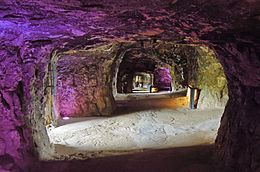Casemates of Luxembourg City
The casemates of the city of Luxembourg are caves and passages carved into the rock that were created for defensive purposes from the 17th century and were originally part of the fortress of Luxembourg .
history
The city's first casemates were built during the period of Spanish rule in 1644. Forty years later, the French military engineer and fortress builder Vauban had them expanded. He gave the part of the casemates known as Petruss Casemates (name after the Petruss river below ) its current shape. In 1745 the underground facility was further expanded, this time under the rule of the Austrians. The part called Bock Casemates was built in the Bock rock and was 110 m long and only 7 m wide. The total length of the casemates was formerly 23 km, with the defense system being laid out over several floors and some passages reaching a depth of 40 m. Around 1,200 soldiers with 50 cannons were stationed in the Bock casemates alone. In view of this fortress, Luxembourg was given the nickname “ Gibraltar of the North”.
In the War of the First Coalition (1792-1797) long during the eight months siege of Luxembourg resided the Habsburg field marshal Blasius Columban Bender until his surrender in the rooms of Casemates du Bock. After Luxembourg was declared neutral at the London Conference in 1867 , the entire fortress of the city was evacuated and razed . The demolition work lasted 16 years, and the casemates were not spared either. 17 km of the original 23 km long corridors have been preserved. Destruction of the entire complex would have affected the town's settlement structure . After the fortress was demolished, the loopholes and entrances were closed. Later, the Saint Sebastian Brotherhood used part of the facility for their bow shooting practice and a gardener used the cool and dark caves to grow mushrooms.
In 1903 the Petruss Casemates were completely closed, but were reopened to the public in 1933. During the two world wars , the underground passages served the Luxembourg population as shelters from bombing raids ; up to 35,000 people could find protection in this way.
The city's archives have over 1300 maps and plans of the entire fortress and some houses in the basement still have access to parts of the casemates.
Todays use
The casemates are one of the most important sights in Luxembourg City. Over 100,000 visitors visit the former underground defenses every year. The corridors are illuminated and specialists make tourists from all over the world familiar with the history of the facilities in guided tours. The fortress and the old town of Luxembourg have been on the UNESCO World Heritage List since 1994 .
Trivia
Numerous streets in and around the city of Luxembourg have names that are directly or indirectly related to the fortresses and defenses located here. So z. As the Rue Jean-Pierre Koltz , in Luxembourg's Hollerich , reminiscent of Jean-Pierre "Jemmy" Koltz that much of his life researching had dedicated the fortress history and is due to the fact that the fixed and opened Petrusse Casemates and opened to the public in 1933.
literature
- Luxembourg City Tourist Office (ed.): The casemates . Luxembourg 2012 (information brochure).
Web links
Individual evidence
- ↑ In 2006 there were 129,682 visitors, see: How the casemates became touristy , Luxemburger Wort , July 1, 2017.
- ↑ Memories of the fortress - street names that tell a story , Luxemburger Wort , July 3, 2017.



